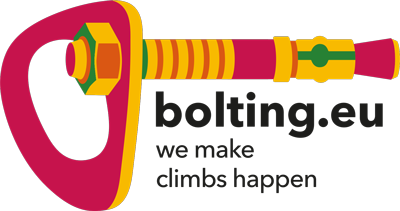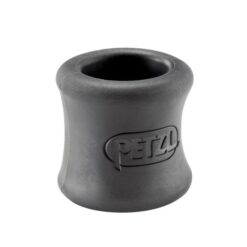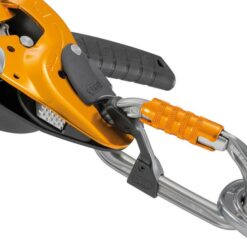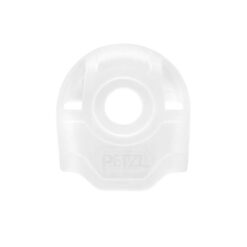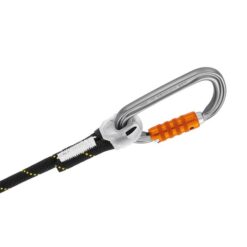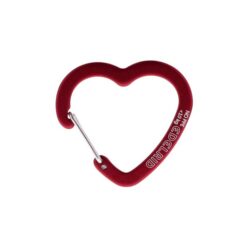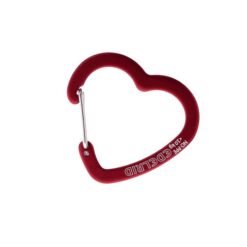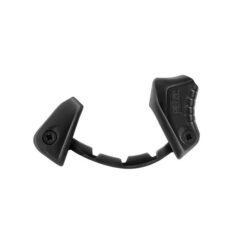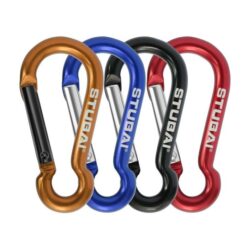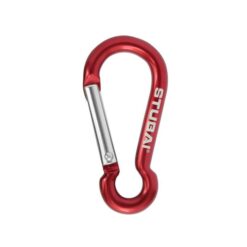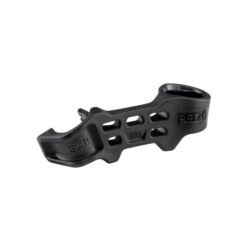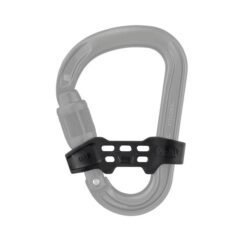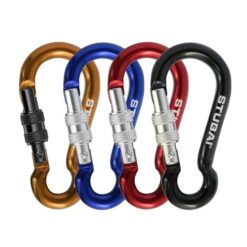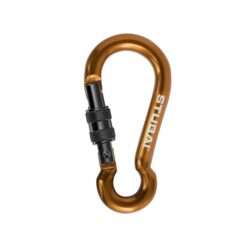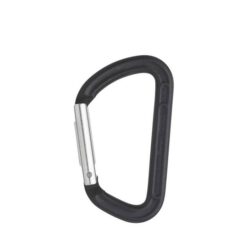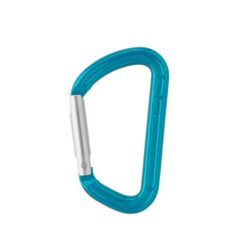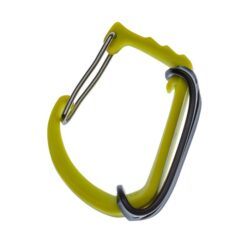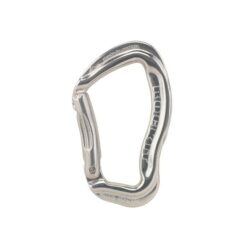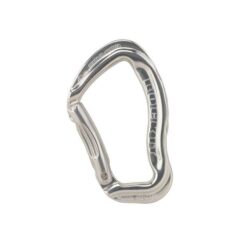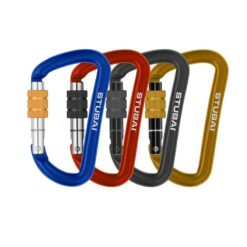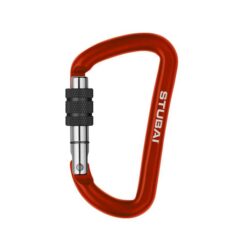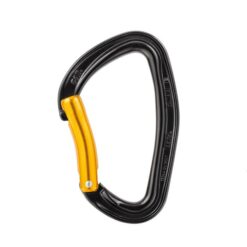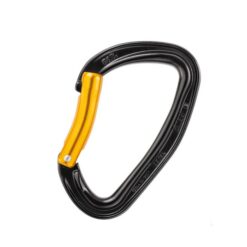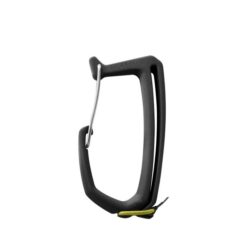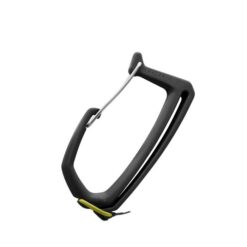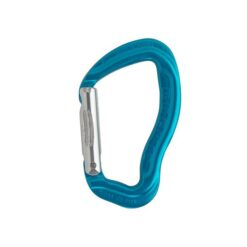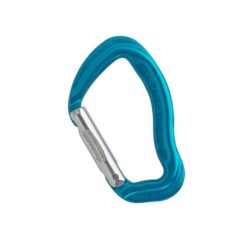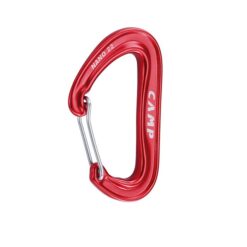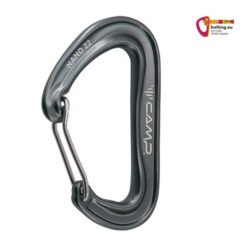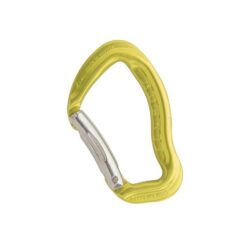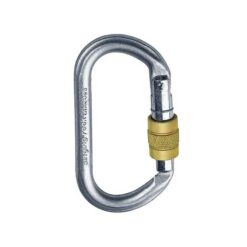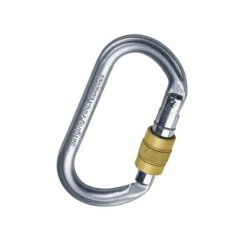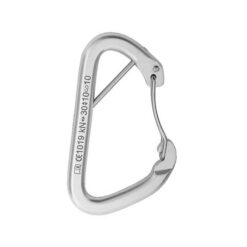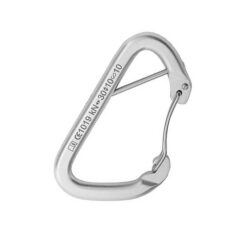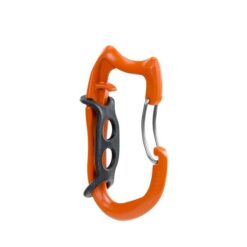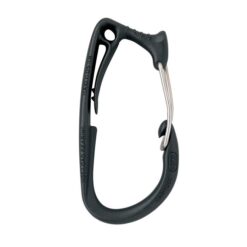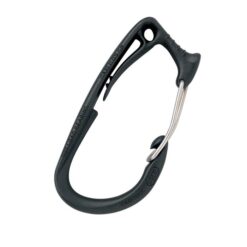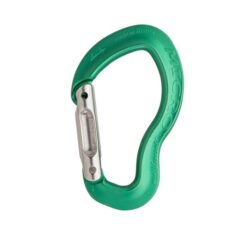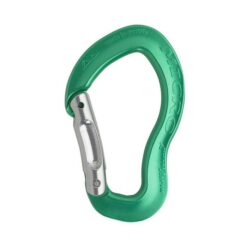incl. 20% VAT
incl. 20% VAT
incl. 20% VAT
incl. 20% VAT
incl. 20% VAT
incl. 20% VAT
incl. 20% VAT
incl. 20% VAT
Climbing carabiners – also known as lanyards – are an essential part of any climbing equipment. However, not every climbing carabiner is the same.
Nothing works in climbing without them – climbing carabiners!Firstly, they differ greatly in their shape. Secondly, also in their type of closure. And thirdly, in terms of the material. They can also be distinguished on the basis of the manufacturing process. This is because these products are both cold and hot forged.
Consequently, the respective combination of features also results in very different uses. They offer a very good way of typifying lanyards for climbing sports.
That’s why we’ll give you an overview of the different types of carabiners below.
Climbing carabiners – by type
One way of clearly structuring the topic of carabiners is to use types. By this we mean the broad categories into which this item of equipment can be divided.
Material carabiner
A typical material carabiner. Not intended for climbing, but only as an accessory!
This category includes all small models that do not comply with EN standard 12275. You may also know them as “accessory carabiners”, “catch carabiners” or “mini carabiners”.
Strictly speaking, these products are not climbing carabiners. This is because, as already mentioned, they do not meet the appropriate standard. This means that they break even under low loads and are not suitable as lanyards for climbing itself.
However, they are used for many different purposes when climbing. For example, to fix the leashes of your rock hammer, to attach your drinks bottle or to attach your chalk bag.
Material carabiners are also popular as key rings, for attaching dog leads, etc…
snapgate carabiner
A classic snapper with keylock closure from Stubai
This type is easy to recognize. Firstly, they should all have the EN 12275 lettering. And secondly, they have a normal catch or wire catch.
Put simply, this means that a positive always engages with a negative. On the one hand, this makes it possible to insert something into the snapgate carabiner such as a climbing rope. On the other hand, the closed gate gives the carabiner its large breaking load in the longitudinal direction.
For this reason, a reliable locking system is the be-all and end-all for this type. The so-called “keylock” and the wire gate have proven to be the best.
Manufacturers such as Petzl and Camp have brought out combinations or heavily modified versions of these. For example, the Petzl Ange Finesse Express and the Camp Dyon Snapper.
The Austrialpin Micro, a model with a classic wire shackle fastener.Basically, however, there are only these two types of snapper and their derivatives.
It is worth mentioning that the wire snappers prevent the so-called “whiplash effect”. This refers to the opening of the snapper due to its mass inertia in the event of a fall.
Or better explained: normal catches can open in the event of a fall because they are quite heavy. This cannot happen with a wire gate.
Of course, the weight saving is a welcome (side) feature!
Lockable climbing carabiners
Another large group are the locking carabiners. These can also be divided into further sub-categories.
screwgate carabiner
The Petzl SM’D Screw Lock is an extremely popular, small screwgate carabiner!
Firstly, the classic screwgate carabiner. Here, the catch is opened and closed manually with the help of a turning thread. In contrast to the models below, these models do NOT close automatically!
This fastener is therefore ideal if a lanyard only needs to be opened occasionally. And secondly, in poor external conditions. Namely when automatic latches can fail. This can be the case in ice and snow, for example, as well as dirt such as mud.
That’s why alpinists like to have screwgate carabiner with them. They are also popular as fixed carabiners on alpine routes.
Twist-Lock climbing carabiner
The Austrialpin Rondo in the 2-way twist-lock version.
Secondly, there are the so-called twist-lock carabiners. Here, a swivel joint is opened in several steps. Depending on the number of steps, this is referred to as a “2-way” or “3-way” twist lock. These closures are fitted with a spring so that they close automatically. This is the big advantage over screwdrivers.
In other words, they are ideal wherever you need to be able to quickly counteract. And on the other hand, where the lockable carabiner has to be clipped in and out very often. For example, on a multi-pitch route.
Please note. The automatic locking mechanism of this type of carabiner can fail in ice and snow or if there is a lot of dirt.
Ball-Lock carabiner
The Petzl AM’D Ball Lock is THE ball lock carabiner par excellence!
Thirdly, there is also the “Ball-Lock” closure from Petzl, where you first have to press a small green plastic ball to open the gate. This locking system then closes automatically. It is very similar to the Twist-Lock, only a little quicker.
This is why it is extremely popular for self-arrests, for belaying or for attaching the GriGri 2 or GriGri Plus to climbing harness.
The same applies here. In adverse conditions, the catch may no longer close automatically.
Incidentally, Ball-Lock carabiners are only available from Petzl, as this technology is a current patent of the French market leader.
“Slider” climbing carabiner
The Austrialpin Rondo in the “Slide” version.
Fourthly, there has been another fastener for a few years now. The so-called “slider”.
Depending on the manufacturer, these are small “sliders” or “nubs” on the catches. The catch can only be opened by pushing, pressing or squeezing them.
The “Twin-Gate” system from Beal is a completely unique locking system for lanyards. The carabiner has two opposite gate catches. This makes unintentional unhooking impossible.
The handling does take some getting used to. But the increasing popularity as a belay carabiner proves the French and their system right.
Via ferrata carabiner
The Salewa Ergotec with palm protection, a typical via ferrata carabiner.
This locking system occupies a special position among climbing carabiners. On the one hand, the locking mechanisms cannot be compared with any other system. And secondly, some of them have a completely different shape to regular carabiners.
So there are the via ferrata carabiners with the so-called “Zwick closure”. This means that the gate is pinched with the thumb and index finger so that it can then be moved or opened. Classic examples are the Camp Nomad via ferrata carabiner and the Petzl Vertigo Wire Lock.
The second system is the “palm safety catch”. Here you have to press a mechanism with the ball of your hand so that the gate opens. Representatives of this type are the Kong Tango or Salewa Ergotec via ferrata carabiners.
Climbing carabiners by material
Fasteners should have very specific properties depending on their intended use. Sometimes they should be light. Other times they should be extremely abrasion-resistant. Then sometimes they should be extremely resilient. And then, for example, they should be fixable in a climbing anchor as lower off.
With all these requirements, it soon becomes clear. One material alone is not enough. That’s why there are products made from four different materials.
Aluminum climbing carabiner
With polished carabiners, the fact that they are made of aluminum is particularly visible.
As a rule, climbing lanyards are made of aluminum. A relatively high proportion of zinc is added to achieve the required properties such as high breaking load and sufficient ductility. In other words, we are dealing here with an aluminum-zinc alloy.
This material has exactly the desired properties. It can also be cold-formed. Some manufacturers, such as Austrialpin, only produce their products using this process. To put it simply, “only” relatively simple cross-sections and shapes can be produced. The material is heated and cooled rapidly, but only to achieve the desired strength.
And on the other hand, this alloy can also be hot-forged. Manufacturers such as Petzl, Camp or Climbing Technology can do this. This means that the alloy is heated to such an extent using furnaces that it can be pressed into complex shapes. Like complicated H-profiles or T-shapes. This means that very light but strong shapes can be produced.
Perfect examples are the Petzl Spirit Screw Lock, the Camp Nano Snapper or the carabiner for the Edelrid Nineteen G Set.
Steel carabiner
Steel carabiners are easy to identify by their heavy weight!
Steel carabiners are made of either zinc plated steel or stainless steel. The difference lies in the steel alloy and the surface treatment.
This is because zinc-plated karabiners are made from “cheaper” ferritic steels, which are then coated in an electrochemical process zinc plated. This means that their protection against oxidation (“rusting”) is a zinc coating.
Stainless steel carabiners, on the other hand, are made from more expensive and higher quality “austenitic steels”. This steel also has a significantly higher chromium content. This means that a chromium-dioxide layer forms on the surface during production. In simple terms, this means that the iron molecules can no longer be oxidized. As a result, these carabiners are extremely durable and should never rust in the Alps, for example.
The climbing carabiners made from these two steel qualities have one thing in common. They are extremely abrasion-resistant! However, they are also very heavy. This is why they are used almost exclusively as fixed carabiners. For example, the Fixe Indus for fixed indoor quickdraws, or the Austrialpin D-Assym as a deflection carabiner for climbing anchors. This also makes them ideal for work at heights.
Unsurprisingly, steel carabiners are also extremely resilient. The breaking load of some models is 50kN, i.e. 5 tons. For example, the Kong X Large, Camp D Pro Lock or Stubai Super 5000, which makes them perfect for use in construction, forestry and agriculture.
Hybrid carabiner
The Edelrid Bulletproof Screw FG is a typical hybrid carabiner.
Edelrid has managed to make the best of both materials. Namely hybrid climbing carabiners made of aluminum with steel inlets at apex. These models can be recognized by their designation “Bulletproof”.
The system is both simple and borderline ingenious. The frame of the carabiner is made of lightweight aluminum. However, the crucial part, namely the inside of the apex, is equipped with a highly abrasion-resistant stainless steel inlet.
Where does this make sense? Firstly, with all lanyards that are used with descender or belay devices. Such as Edelrid Jul 2 or Mega Jul, the Petzl Reverso, etc…. Where normal aluminum carabiners already have deep notches, the Bulletproof models remain as good as new!
Secondly, these models also make sense on the side of the bolt in quickdraws. There, the Bulletproof Straight gate never causes the deep, sharp notches that occur with the aluminum models. And an Edelrid Bulletproof Bent in the first quickdraw prevents the typical notch caused by lowering.
Climbing carabiners by shape
The many different types can also be easily categorized according to their shape. It is not for nothing that the EN 12275 standard for carabiners for climbing also refers to this. In other words, it assigns separate designations to the respective shapes.
And secondly, the respective shapes must also withstand different minimum breaking loads for carabiners. See table below!
B-type
Put simply, these are all “snappers”. I.e. self-closing models for use in a safety system. Consequently, these can be catches with wire bail and normal keylock catches.
Classic examples are the Austrialpin Rockit Schnapper, the Stubai Rock Clip or the Kong Bent Gate.
D-type
The “D” here stands for “directional”. This means that it includes all models that have a device for alignment along the longitudinal axis. These are mainly products that are used with belay devices. They often have an additional, small gate that fixes the climbing carabiner to the rope loop of the climbing harness. This prevents the harness from turning and avoids dangerous cross-loading.
Examples include the Austrialpin Rondo Selfie, the Edelrid HMS Strike FG or the Edelrid HMS Bulletproof Screw FG.
X-type
This category includes all carabiners with a symmetrical shape. This means all “oval” models such as the Austrialpin Ovalo gate.
H-type
This category includes all models with a snapper locking device. I.e. all screwdrivers, twist locks and ball locks.
K-type
They are a very special type of climbing carabiner: via ferrata carabiners! Of course, consideration is given to the EN 12275 standard. This means that they have to withstand their very own breaking loads.
Q-type
Quick links, better known as screw links, also fall under the EN 12275 standard. They carry the extension “Q” and must withstand the highest of all shear loads. Namely 10kN.
Overview of carabiner types and strength values
Overview table of types and strength values according to EN 12275 and UIAA 121 standard (taken from en.wikibooks.org)
Carabiners without the EN standard or UIAA standard have no place in climbing. Cheap DIY store models are an absolute “no go”!
Special climbing carabiners
Of all the types of fasteners presented so far, a few stand out in particular. For this reason, we would like to introduce you to a few “special forms” that are worth mentioning.
We hope to make this list as complete as possible. So that you simply get a perfect overview of the topic.
HMS carabiner
The Petzl Attache HMS, one of THE HMS carabiners on the market!
You can make a munter hitch in HMS models. The decisive factor here is that the knot “jumps” in such a product. Or to put it better. With these lanyards, you can use the half-mast belay if necessary or also with munter hitch rappelling .
This results in an ideal shape and size for this type. Consequently, these carabiners are only available in pear shape and from a medium size. Several other sizes are available upwards.
This makes them more suitable for half-mast belaying or rappelling with half ropes or double ropes. They are also perfect for use as a central carabiner.
Small screwgate carabiner e.g. are not suitable for the munter hitch. Consequently, they cannot be HMS carabiners either.
“Twisted” climbing carabiners
In certain situations, it is advantageous if a lanyard has a “twisted” shape. This is the case with some rescue techniques and at work at heights. Namely when pulleys are used or loads are lowered or redirected.
The following video on the Kong Ovalone DNA shows the obvious advantages of this special shape.
Models with sheaves
The DMM Revolver – a model with a sheave!
Climbing carabiners with sheaves are another important special form. The DMM Revolver should be mentioned here first and foremost. This model has a sheave in the narrow apex. This allows the rope to slide smoothly.
This can be extremely helpful in many situations. For example, on routes with zig-zag ropes. Also with pulley systems. And also in places where there are traditionally hard falls.
For lifting and lowering loads, we also have a carabiner with ball bearings in our range, which is specially designed for work at heights.
What does “polished” mean for climbing carabiners?
An example of a “polished” model – the Austrialpin Micro screwdriver.
This means that the fastener was treated purely mechanically. Not chemically. Just polished. This results in an even and smooth surface. These “untreated” product types are therefore only available in “silver”.
On the one hand, such models are inexpensive. On the other hand, however, they are not resistant to strong corrosion factors. When climbing near the sea, for example, you will develop a rougher, duller surface over time. In extreme cases, the sodium chloride will severely corrode the surface and you will have to discard the carabiners.
Therefore important. Rinse often with drinking water!
What does “anodized” mean?
Coloured models are usually always anodized!
This means that an extra protective layer has been applied to the carabiner using a chemical process. As a result, this refined type is better able to withstand chemical influences. These can be salts, climbing talc or rain. As a result, such models are more durable than “polished” ones.
As a rule, color is also added during this process. This means that all “coloured” lanyards are automatically “anodized”. The color on the climbing carabiners also helps you to tell the different models apart.
You can read more about the “anodizing process” on Wikipedia.
Can carabiners break?
Depending on how the forces are applied, (rare) breaks can indeed be possible. It is therefore essential to avoid cross-loading by resting on the rock or a belay point (e.g. getting stuck in the piton).
If used carefully, the probability of a carabiner breaking is therefore extremely low!
Which climbing carabiners belong to which gear?
What your “rack” should look like depends very much on your climbing habits. For example, someone who occasionally goes to the gym has completely different requirements than a motivated alpine climber.
Consequently, there are no binding guidelines. However, we have made a small recommendation for beginners.
Indoor climbing: All you need is a lanyard with a secure locking mechanism that is compatible with your belay device.
Sport climbing: You need a suitable belay device combo like the one above. In addition, at least two small screwdrivers for rethreading the rope on the lower off (1 x for lanyard (fix with clove hitch!), 1 x for fixing the rope in the tie-in point). Finally, for 1-2 extendable quickdraws you will need four normal snappers.
We also recommend 10 short and 2-4 long quickdraws for beginners.
Alpine climbing: Firstly, you need a large HMS that fits your belay device for double ropes.
Then another large HMS that serves as a central attachment point on belay station. In addition, a small screwdriver for attaching the belay device (Reverso or similar) and ideally an oval climbing carabiner for belay mode.
You should have two oval or two smaller screwdrivers with you for stand construction.
In the Alps, we recommend two to four extendable quickdraws. This means you also need up to 8 snappers.
You should also have about eight short and four to six long ones for your Expressen arsenal.
FAQ’s
Which standard for climbing carabiners?
Climbing carabiners for alpine sports must be standardized in accordance with EN 12275 . Different breaking load values apply for the respective types (B,H, K,A,T,Q,X). The standard must be shown on the carabiner itself.
What is a wire gate carabiner?
These are climbing carabiners with a gate made of lightweight steel wire, known as a “wire gate”. On the one hand, this reduces the weight by a few grams. And secondly, due to the low inertia, such gate catches cannot open themselves in the event of a fall.
What is a ball lock?
This is a climbing carabiner with a patented locking system from the French company Petzl. This carabiner can only be opened by pressing a small green ball on the gate and then twisting it. Ball-Lock carabiners then close again automatically.
Can climbing carabiners break?
An unfavorable combination of cross-loading and leverage can cause carabiners to break. The most dangerous scenarios are a) the carabiner resting on a rock edge and a simultaneous fall and b) twisting in a fixed point (cross-loading in piton, bolt hanger, glue in bolt) and a simultaneous fall.
What are climbing carabiners made of?
These consist of an aluminum-zinc alloy. This is considerably lighter or stronger than the individual metals themselves. Put simply, the aluminum gives the alloy its strength and the zinc its flexibility. Strong heating (approx. 800°C) and shock-like cooling give this alloy its extremely resistant molecular structure for the high breaking loads required of karabiners.
When should carabiners be discarded?
Carabiners for climbing must be discarded immediately if… Firstly, the gate or clasp can no longer be closed (after cleaning and oiling). Secondly, if the apex on the side of the rope is too worn or has sharp edges. Thirdly, if the apex on the side of the bolt has deep notches from the sharp bolt hanger edges.
